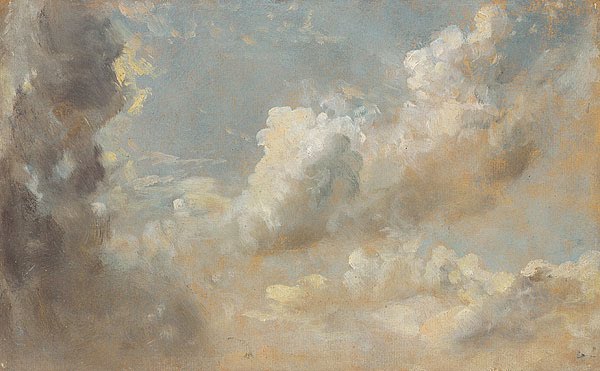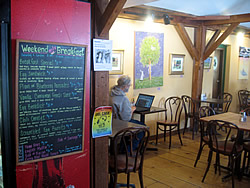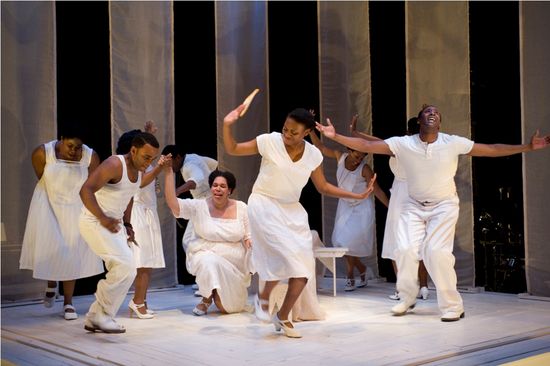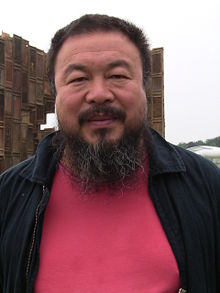 In theory, Mrs. T and I divide our time between New York City and an old farmhouse deep in the woods near Storrs, a college town located in the quiet corner of Connecticut. Alas, this theory has taken a beating of late. We flew down to Florida in January so that I could put in my annual stint as a scholar-in-residence at Rollins College, our new home away from home, and I didn’t set foot in Storrs again for the better part of five months. No sooner did I return to Manhattan than I got stuck on Broadway, reviewing show after show, and in Philadelphia, seeing Danse Russe onto the stage. Not until Memorial Day was I able to pack a bag, rent a car, drive to northeast Connecticut, and rejoin Mrs. T at our little place on Chaffeeville Road.
In theory, Mrs. T and I divide our time between New York City and an old farmhouse deep in the woods near Storrs, a college town located in the quiet corner of Connecticut. Alas, this theory has taken a beating of late. We flew down to Florida in January so that I could put in my annual stint as a scholar-in-residence at Rollins College, our new home away from home, and I didn’t set foot in Storrs again for the better part of five months. No sooner did I return to Manhattan than I got stuck on Broadway, reviewing show after show, and in Philadelphia, seeing Danse Russe onto the stage. Not until Memorial Day was I able to pack a bag, rent a car, drive to northeast Connecticut, and rejoin Mrs. T at our little place on Chaffeeville Road.
New York is…well, it is what it is and then some, and if that’s what you want, you know what to do. I’ve lived there for a quarter-century and find it hugely stimulating. Most of the time I love catching cabs and sitting on the aisle and seeing my beloved friends whenever I please. But regular readers of this blog don’t need to be reminded that I’m a small-town boy from way back, and New York, for all its self-evident splendors, does have a sneaky way of grinding you down.
 Not so Storrs, which is as tranquil as a cloud study by Constable, so much so that longtime residents not infrequently refer to the town as “Snores,” sometimes affectionately and sometimes wryly. Mrs. T, as it happens, was born near Storrs and moved back to her old home town many years later, and when I visited her for the first time five years ago, I knew that I wanted to spend as much time there as I could.
Not so Storrs, which is as tranquil as a cloud study by Constable, so much so that longtime residents not infrequently refer to the town as “Snores,” sometimes affectionately and sometimes wryly. Mrs. T, as it happens, was born near Storrs and moved back to her old home town many years later, and when I visited her for the first time five years ago, I knew that I wanted to spend as much time there as I could.
I sleep better in Storrs, flinging my bedroom window open to hear the gentle sounds of the night, and I write better, too, no doubt because of the near-complete lack of opportunities for distraction. In New York I have to be constantly on guard in order to get anything done. In Storrs, by contrast, I can sit down at my desk secure in the knowledge that nobody is likely to bother me.
 Needless to say, I didn’t plan to spend the whole spring in Manhattan, and by the time I finally managed to hit the road on Monday, I was well and truly frazzled, in part because I’d spent virtually all of Sunday writing a 2,500-word essay from scratch. But no sooner did I cross the state line than I felt my cares melting away, and when I pulled into our driveway, smelled the deep-green scent of the meadow across the way, and heard the neighborhood rooster, who has the confusing but endearing habit of crowing not at sunrise but whenever he pleases, I knew I was home again.
Needless to say, I didn’t plan to spend the whole spring in Manhattan, and by the time I finally managed to hit the road on Monday, I was well and truly frazzled, in part because I’d spent virtually all of Sunday writing a 2,500-word essay from scratch. But no sooner did I cross the state line than I felt my cares melting away, and when I pulled into our driveway, smelled the deep-green scent of the meadow across the way, and heard the neighborhood rooster, who has the confusing but endearing habit of crowing not at sunrise but whenever he pleases, I knew I was home again.
 I hasten to point out that I’m not–repeat, not–on vacation. I have to write and file two Wall Street Journal columns this week, and once they’re done, I have plenty of other work to do before we go back to New York on Friday to see the Mint Theater Company‘s revival of Rachel Crothers’ A Little Journey. But I don’t have to start writing until Wednesday, so Mrs. T and I plan to take today off. We’re going to sleep late, have lunch at the Vanilla Bean Café, then go for a nice long drive to nowhere in particular. Come evening we’ll eat a home-cooked supper, curl up on the couch, and watch a movie.
I hasten to point out that I’m not–repeat, not–on vacation. I have to write and file two Wall Street Journal columns this week, and once they’re done, I have plenty of other work to do before we go back to New York on Friday to see the Mint Theater Company‘s revival of Rachel Crothers’ A Little Journey. But I don’t have to start writing until Wednesday, so Mrs. T and I plan to take today off. We’re going to sleep late, have lunch at the Vanilla Bean Café, then go for a nice long drive to nowhere in particular. Come evening we’ll eat a home-cooked supper, curl up on the couch, and watch a movie.
That sounds to me like the best of all possible days, spent in the company of the best of all possible wives. So if you’ll excuse me, I’ve got plenty of nothing to do, and I need to get started.
* * *
Mildred Bailey and the Delta Rhythm Boys sing Alec Wilder’s “It’s So Peaceful in the Country” in 1941:
Archives for 2011
TT: Almanac
“Any book born of a grudge is built on sand.”
Wesley Stace, Charles Jessold, Considered as a Murderer
TT: In memoriam
Herbert von Karajan conducts the first movement of Verdi’s Requiem at La Scala in 1967. The soloists are Leontyne Price, Fiorenza Cossotto, Luciano Pavarotti, and Nicolai Ghiaurov:
TT: Almanac
“Courage is almost a contradiction in terms. It means a strong desire to live taking the form of a readiness to die.”
G.K. Chesterton, Orthodoxy
HAVE OUR CULTURAL STEWARDS ABANDONED ONE OF THEIR OWN?
“It strikes me that instead of being ‘cautious’ not to ‘impose’ American values on a foreign culture, the museums of America should acknowledge that they have a unique responsibility to speak out on behalf of Ai Weiwei. They are, after all, trustees of the cultural heritage of mankind, which makes them by definition guardians of the universal values of civilization. Yet most of them are carefully looking the other way while China thumbs its nose at those same values by unlawfully imprisoning an artist. That’s not caution, it’s cowardice….”
TT: The church on Catfish Row
In today’s Wall Street Journal I file the first of two reports on my recent visit to Chicago. This week I review the Court Theatre’s Porgy and Bess and TimeLine Theatre’s The Front Page, both of which are sensationally good. Here’s an excerpt.
* * *
Nowadays most people think of “Porgy and Bess” as an opera, but it began life on Broadway, and there’s a strong case to be made for performing the American “Carmen” (which is what “Porgy” is) not as a big-house opera but as a straight-from-the-shoulder music drama (which is what “Carmen” is). That’s what Charles Newell has done in his soul-stirring revival, a radical rethinking of George Gershwin’s rambling masterpiece that transforms it into a concise two-act chamber opera for 15 singers and six instrumentalists. Though it’s nothing like the “Porgy” that Gershwin and his collaborators envisioned, Mr. Newell’s new version is so emotionally true to the spirit of the piece that any lingering reservations you may have about its modest scale will quickly be swept away.
 No sooner do you walk into the 250-seat Court Theatre than you see what Mr. Newell and his production team are up to. The set, designed by John Culbert, is a wooden platform whose bleached planks evoke a one-room country church. The cast is dressed in white (the only splash of color is the blood-red negligée that Porgy buys for Bess) and the atmosphere is that of a revival meeting. One might almost be present at the evangelical equivalent of a 13th-century liturgical drama, a latter-day “Play of Porgy” in which the timeless tale of a crippled Catfish Row beggar (Todd M. Krygar) who falls for a cocaine-snorting tramp with a heart of gold (Alexis J. Rogers, who is devastatingly sexy) is enacted before the altar.
No sooner do you walk into the 250-seat Court Theatre than you see what Mr. Newell and his production team are up to. The set, designed by John Culbert, is a wooden platform whose bleached planks evoke a one-room country church. The cast is dressed in white (the only splash of color is the blood-red negligée that Porgy buys for Bess) and the atmosphere is that of a revival meeting. One might almost be present at the evangelical equivalent of a 13th-century liturgical drama, a latter-day “Play of Porgy” in which the timeless tale of a crippled Catfish Row beggar (Todd M. Krygar) who falls for a cocaine-snorting tramp with a heart of gold (Alexis J. Rogers, who is devastatingly sexy) is enacted before the altar.
This is not, in other words, a stripped-down Broadway-style “Porgy” but a genre-transcending theatrical experience staged in such a way as to shift the emphasis from Gershwin’s score to DuBose Heyward’s often-underrated libretto….
Just as “Porgy and Bess” is now best known as an opera, so is “The Front Page” now best known as a movie. In the original 1928 stage version, Ben Hecht and Charles MacArthur introduced Broadway audiences to the scoop-hungry crime reporters who covered Chicago in the age of Al Capone. But when Howard Hawks made “His Girl Friday” in 1940, he turned Hildy Johnson, the tough-guy reporter of “The Front Page,” into a woman, in the process changing a hard-nosed farce about journalism in America into a screwball comedy about the perils of workplace romance. The results were so funny that no one complained, but the play got lost in the shuffle, and revivals are now as scarce as evening papers.
All praise, then, to Chicago’s TimeLine Theatre for resurrecting “The Front Page” and giving it a staging so full of brassy brio that you’ll wonder why you ever settled for less. Performed in the round in the company’s 99-seat theater, it puts you so close to the action that you can actually smell the ketchup on the hamburgers eaten by the characters in the first act. The acting fizzes with outrageous, nose-thumbing vitality–PJ Powers and Terry Hamilton couldn’t be better as Hildy Johnson and Walter Burns, Hildy’s unscrupulous boss–and the ultra-realistic set, designed by Collette Pollard, is so suitably grubby that you’ll want to grab a broom and start sweeping….
* * *
Read the whole thing here.
TT: Have our cultural stewards abandoned one of their own?
My “Sightings” column in today’s Wall Street Journal is about Ai Weiwei. Here’s an excerpt.
* * *
 China locked up best-known artist nearly two months ago. Ai Weiwei, who is both a widely admired conceptual artist and a fearless human-rights activist, has been on the bad side of the Chinese government for years. Officials claim that he was imprisoned for tax evasion, but given China’s notorious intolerance of dissent, it’s an ultra-safe bet that his real “offense” was that he dared to criticize the tyrannical bureaucrats who run his native land, not just once but repeatedly….
China locked up best-known artist nearly two months ago. Ai Weiwei, who is both a widely admired conceptual artist and a fearless human-rights activist, has been on the bad side of the Chinese government for years. Officials claim that he was imprisoned for tax evasion, but given China’s notorious intolerance of dissent, it’s an ultra-safe bet that his real “offense” was that he dared to criticize the tyrannical bureaucrats who run his native land, not just once but repeatedly….
And what is the art world doing about it? Not much.
To be sure, numerous protests have taken place since Mr. Ai and members of his staff were imprisoned on Apr. 3, one of which was mounted by the Museum of Contemporary Art San Diego. “We are aghast that this has happened and intend to protest as best we can,” MCASD director Hugh Davies told artblogger Tyler Green. But no other major museum in America has taken a similar step (though several museum directors have individually signed an online petition circulated by the Guggenheim Museum that calls for his release). What’s more, the Milwaukee Art Museum and the Virginia Museum of Fine Arts are preparing to open exhibitions of Chinese art organized in cooperation with the Chinese government. To date Mr. Ai’s plight has not led either institution to alter its plans….
In situations like these, of course, it’s worth recalling the precept that every budding doctor learns in medical school: “First, do no harm.” It might well be that the Milwaukee Art Museum would plunge Mr. Ai into hotter water by protesting his imprisonment–but it’s hard to see how that could make his situation any worse. On the other hand, such a protest might also persuade China’s leaders that they can’t expect to keep on doing business as usual with the U.S. unless they release Mr. Ai forthwith.
It strikes me that instead of being “cautious” not to “impose” American values on a foreign culture, the museums of America should acknowledge that they have a unique responsibility to speak out on behalf of Ai Weiwei. They are, after all, trustees of the cultural heritage of mankind, which makes them by definition guardians of the universal values of civilization. Yet most of them are carefully looking the other way while China thumbs its nose at those same values by unlawfully imprisoning an artist….
* * *
Read the whole thing here.
TT: Almanac
“No education is worth having that does not teach the lesson of concentration on a task, however unattractive. These lessons, if not learnt early, will be learnt, if at all, with pain and grief in later life.”
Cyril Connolly, Enemies of Promise
